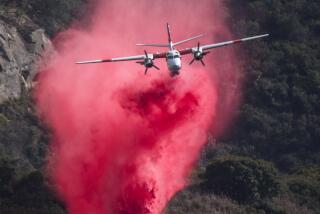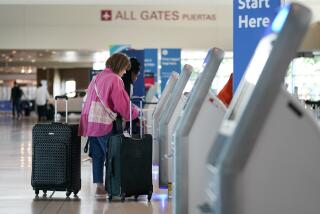No Longer a Flight of Fancy : Aviation: Would-be airline pilots without military experience are more hopeful than ever of landing a job with a commercial carrier.
- Share via
SANTA ANA — In a profession known for its cool heads, Aaron Scott is bubbling over at the prospect of becoming an airline pilot. He still faces another year or two of training to secure the necessary licenses and flying time, but after that, he believes his career could literally take off.
“I feel real good,” said the 28-year-old aviation devotee from Orange. “Everyone in aviation is excited about the potential for growth.”
Scott and other flying enthusiasts point to several reasons why they believe opportunities for new pilots are perking up. Major airlines are expanding on the heels of a profitable year, while commuter airlines are sprouting up throughout the country.
And one of the airlines’ key recruiting sources for new pilots, the military, is drying up. Major airlines, especially Delta, prefer to hire ex-military pilots, but with cutbacks in military budgets, fewer fighter pilots are available.
Scott has developed another gauge that points to a bright future: the white-hair meter. As a plane refueler at Martin Aviation at John Wayne Airport, he’s able to check out the pilots. “Eighty percent of them that get out of that cockpit have white hair. Eighty percent of them are going to be gone” in a few years, he says, pointing out that most airlines have a mandatory retirement age of 60.
Some industry experts agree that the outlook is bright for aspiring pilots.
Major and commuter airlines will be hiring 27,000 new pilots over the next five years to fill new jobs and vacancies created through attrition, estimates the Future Aviation Professionals Assn. of America in Atlanta, a career and financial planning service.
The hiring of pilots “has been steadily increasing,” said Ed Ray, an aviation recruiter for the association. Perhaps more significant, the majority of hires will shift from the military to the civilian sector, he said.
These projections also are fueling hopes that business will pick up at local flight schools, which have endured recessionary turbulence and now are looking to train tomorrow’s airline pilots.
*
While the student load has remained fairly steady, school owners say they think that enrollment will rise as word spreads about more opportunities for pilots.
“In the near future, we should see a lot more [airline pilot] hiring,” said Gary Lackey, owner of Len-Air Aviation at John Wayne Airport, one of many flight schools in Southern California. Lackey said that about 40% of his students are interested in airline careers.
But training is costly and takes time.
Lackey estimates it costs $20,000 to $30,000 to gain the necessary licenses and flight time over three or four years. At that point, a student will have enough experience to land a job at a commuter airline where starting pay can average from $20,000 to $25,000 a year.
While the future may be bright, pay remains low because there still is a glut of applicants banging down the doors of carriers small and large looking for jobs. Some actually pay airlines to let them work as co-pilots so they can build up their cockpit hours and make themselves more marketable.
Students are drawn to such relatively low-wage positions by sheer love of flying and the notion that enough hours behind the stick will earn them a position at a major airline some day.
“If you hit the jackpot and work at the majors, you are being paid six figures to work two weeks out of the month,” said Ray, the aviation recruiter.
That’s good news for eager young pilots like Scott, a former Air Force airman who flies every chance he gets.
For Scott and hundreds like him, success as a pilot is a matter of time--flying time. The number of hours they can spend aloft, particularly in cockpits of more sophisticated aircraft, is the most critical of all requirements.
Scott has surpassed the 190 hours of training at Len-Air that he needs to be eligible for a commercial license. But commuter airlines are seeking pilots with 1,800 to 2,300 hours. Scott says he hopes through his contacts at John Wayne to land some work with charter planes.
*
It can get expensive if aspiring pilots have to rent airplanes to log more flying time. A twin-engine plane rents for $120 an hour--a tab usually split by a pair of students. Multi-engine time is more important than single-engine; turbo-prop time is more important than both.
Other students try to gain hours by becoming flight instructors. But because flight instruction generally limits them to single-engine aircraft, they often consider more extreme steps such as paying to work aboard commuter or cargo planes.
“There’s a huge demand for those wishing to build that time,” said recruiter Ray.
But, he added, most think it’s worth it.
“Flying would be, for some people, like playing golf for a living,” Ray explained.
(BEGIN TEXT OF INFOBOX / INFOGRAPHIC)
Wanted: Airline Pilots
Demand for airline pilots will increase by nearly 30% over the next five years, due to industry growth and an aging work force facing mandatory retirement at 60. Projections for U.S. domestic airlines through the end of decade:
*--*
Pilot New Vacancies work force positions from attrition 1995 137,176 1,171 2,556 1996 139,157 1,981 2,685 1997 139,924 767 2,732 1998 141,710 1,786 2,955 1999 143,804 2,094 3,046 2000 145,961 2,157 3,066
*--*
Pilot Demand
2000: 5,223
Flying Facts
A look at pilots hired between 1991-1994 by major U.S. domestic airlines:
* Average age: 34
* Military background: 84%
* Male: 94%
* Hours of flying experience: 3,500
* Four-year degree: 95%
Source: Future Aviation Professionals of America; Researched by JANICE L. JONES/ Los Angeles Times
More to Read
Sign up for The Wild
We’ll help you find the best places to hike, bike and run, as well as the perfect silent spots for meditation and yoga.
You may occasionally receive promotional content from the Los Angeles Times.






